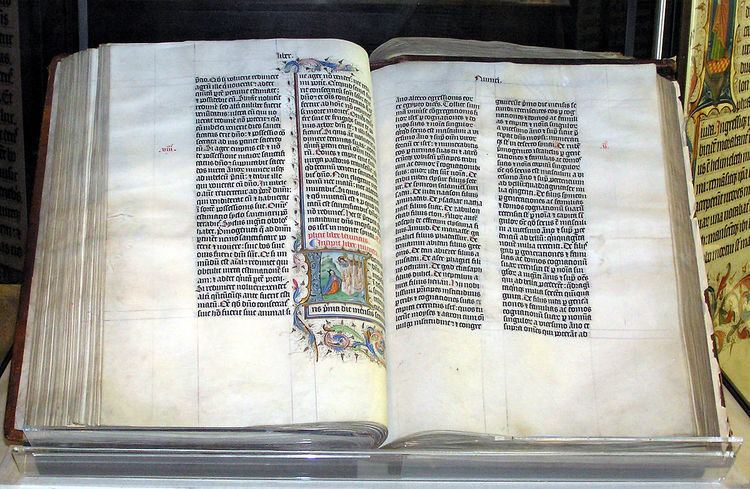 | ||
Bible translations into Hebrew include attempts to translate Biblical Aramaic into the Hebrew language as well as the New Testament—which was likely composed in Koine Greek—into modern Hebrew.
Contents
Hebrew Bible
The Hebrew Bible (i.e. the Tanakh or Christian Old Testament) is almost entirely in Hebrew. However, there are some significant sections in biblical Aramaic: about a third of the Book of Daniel and several quoted royal letters and edicts in the Book of Ezra. These are written in the same square-script as the Hebrew parts, and many readers of the Bible in Hebrew do not require translation for them. Nevertheless, numerous Hebrew translations and paraphrases for these Aramaic parts have been written from the Middle Ages to the present day. The medieval commentary of Gersonides on these books, for instance, contains a Hebrew paraphrase of their Aramaic sections which translates them nearly in their entirety. Many modern editions of the Masoretic Text also contain Hebrew translations of these sections as appendices.
A Christian translation of the Hebrew Bible into Modern Hebrew was completed in 2006 and called "the Testimony" or העדות. Published in four volumes, all volumes are translated into simple, modern Hebrew vocabulary by Shoshan Danielson and edited by Baruch Maoz. "The Ram Bible," תנ"ך רם, began to be published in 2008. Of a planned four volume set, currently the first two, Torah and Early Prophets, are available. These editions include the original text in a parallel column. Some modern Israeli editions of the Bible have running footnotes rendering more archaic words and phrases into Modern Hebrew.
Apocrypha
The books of the apocrypha were not preserved in the Jewish tradition (as reflected in the Hebrew masoretic text). Though the majority of them were originally composed in Hebrew, they have reached us mostly in Greek form, as found in the Septuagint and preserved by the Christian church. A few are extant only in (secondary) translations from the Greek into other languages, such as Latin, Christian Aramaic, or Ge'ez. In modern times there has been renewed Jewish interest in these books, which has resulted in a few translations into Hebrew. In the 19th century most of the apocrypha was translated by Seckel Isaac Fraenkel in Ketuvim Aharonim ("Late Writings" 1830), and a few books were translated by other authors. The Hebrew-language website Daʿat, which collects texts related to Jewish education, has published an online version of these public domain Hebrew translations in digital form; the texts have been formatted and slightly modernized.
Two major annotated Hebrew translations of the apocrypha were published in the 20th century. Both editions include commentaries by the editors, both are vowelized, and both of them incorporate parts of the original Hebrew for Ben Sira that were found in the Cairo Geniza and the Dead Sea Scrolls.
Another annotated Hebrew edition of Ben Sira was published by Moshe Zvi Segal in 1953 and subsequently revised; it also takes into account Hebrew copies found in the Cairo Geniza, among the Dead Scrolls, and at Masada. It is current available from the Bialik Institute.
In the early 21st century, the Yad Ben-Zvi Institute in Jerusalem inaugurated a major project of scholarly publication called Bein Miqra la-Mishnah ("Between the Bible and the Mishnah"), whose scope includes new Hebrew translations and in-depth commentaries on apocryphal books. So far Maccabees 1 & 2 have appeared; Maccabees 3 & 4 and Jubilees are in preparation.
Polemical rabbinical translations
Quotes of the New Testament in Hebrew occur in polemical or apologetic Hebrew texts from the 6th century CE. Three medieval polemical rabbinical translations of Matthew predate the Hutter Bible. A fourth rabbinical translation, that of Rahabi Ezekiel, 1750, may have been the same text as the "Travancore Hebrew New Testament of Rabbi Ezekiel" bought by Claudius Buchanan in Cochin, and later given to Joseph Frey. An ecumenical approach is seen in Elias Soloweyczyk's Matthew, 1869.
The Hutter Dodecaglott Bible
The New Testament was first translated into Hebrew by Elias Hutter in his Polyglott edition of the New Testament in twelve languages: Greek, Syriac, Hebrew, Latin, German, Bohemian, Italian, Spanish, French, English, Danish and Polish, at Nuremberg, in 1599, 1600, in two volumes.
Some individual books were translated before Hutter's complete New Testament, such as Alfonso de Zamora's Letter to the Hebrews (1526). Carmignac (1978) identifies at least 23 translators of the Gospel of Matthew into Hebrew.
Christian translations
As part of the Christian mission to Jews the Greek New Testament has been translated into Hebrew several times since the 19th century. These versions sometimes exist in bilingual editions.
These Christian versions generally use the Hebrew word משיחיים Meshiẖiyyim ("Messianics") for Greek Χριστιανοί Khristianoi ("Christians") in the text in preference to the Talmudic term נוצרים Notsrim ("Nazarenes").
The majority of these versions use the Tetragrammaton (YHWH) when citing quotations from the Hebrew Bible, although this does not mean that Hebrew-speaking Christians necessarily pronounce aloud the name as "Yahweh", any more than Hebrew-speaking Jews, and may read as "Adonai" or "HaShem."
Gospels of Matthew
Gospels of Mark
Gospels of Luke
Gospels of John
Hebrew Gospels
New Testament
Acts
Epistles
